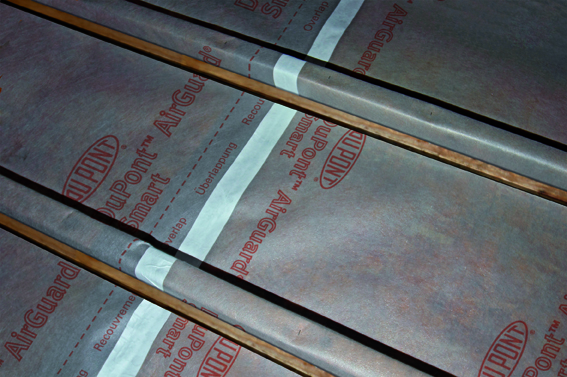Insulation techniques have been developed to make new and existing houses more thermally efficient. Brick and masonry structures have modern insulation applied to either internal or external walls to ensure homes retain heat longer and achieve very good thermal values. Nick Williams from DuPont looks at how air and vapour control is critical to achieving greater energy efficiency.
 With the trend towards greater energy efficiency in buildings, as driven by Building Regulations, it has become clear how air tightness plays a vital role in meeting these standards. Air tightness protects the insulation against air movement and humidity, both of which have a negative impact on the thermal performance and therefore the energy balance of a building.
With the trend towards greater energy efficiency in buildings, as driven by Building Regulations, it has become clear how air tightness plays a vital role in meeting these standards. Air tightness protects the insulation against air movement and humidity, both of which have a negative impact on the thermal performance and therefore the energy balance of a building.
For many building designs, the correct installation of air and vapour control layers (AVCLs) has become the standard in order to meet requirements such as Part L 2013, which came into effect in April 2014.
Why is an AVCL is necessary?
An AVCL has two basic functions: Controlling the amount of vapour that travels through the building envelope; and providing an airtight seal when properly installed and maintained. Various studies show that an AVCL is necessary to prevent moisture from the interior migrating through the walls or ceiling, which could result in mould formation, structural damage, heat loss and increased energy costs.
Effective sealing of the building envelope requires both good workmanship and the right choice of AVCL. Water vapour, which can find many ways into the construction, from wet trades to occupier activity, is difficult to control and could result in risks to both the building and its occupants.
 Any AVCL should be airtight by definition. The degree of vapour diffusion, however, depends on the material composition. It can be distinguished by four different product technologies: Solid Polyethylene membranes, typically with high and fixed sd-values; composite AVCL membranes with low to medium fixed sd-values; Reflective AVCLs; and ‘smart’ AVCLs with adaptable sd-values by means of humidity concentration.
Any AVCL should be airtight by definition. The degree of vapour diffusion, however, depends on the material composition. It can be distinguished by four different product technologies: Solid Polyethylene membranes, typically with high and fixed sd-values; composite AVCL membranes with low to medium fixed sd-values; Reflective AVCLs; and ‘smart’ AVCLs with adaptable sd-values by means of humidity concentration.
Under normal room humidity levels (40-70%), the water vapour resistance of a variable AVCL will not only block moisture transmission during the winter months, but, crucially, also enables drying out of unwanted humidity in the structure during the summer months. Many roof and wall assemblies are only durable if they can fully dry-out. In many cases moisture damage can be attributed to the fact that a vapour barrier is practically impermeable in both directions, i.e. it does not permit any drying out.
Polyethylene membranes typically offer high vapour resistance but can also quickly become a moisture trap. AVCLs with a variable sd-value offer excellent protection against condensation risk and potential damage due to their adaptability. The broader the sd-value range of a variable AVCL, the higher the humidity protection.
DuPont has developed a special laminate technology for its adaptable AVCL DuPont™ Airguard® Smart which provides outstanding humidity protection compared to other AVCLs, and helps to accelerate the drying out process of wet construction materials. Its capacity is approximately 1,400-2,000 times greater than Polyethylene sheets and 5-6 times greater than comparable AVCLs with a variable sd-value.
However, different conditions within buildings will require different membranes. For rooms with extreme humidity levels (>70%), AVCLs with high sd-values are recommended for installation after the drying out of construction materials, but special care should be given to the installation method to avoid moisture being trapped in the construction, since the high sd-value does not allow for drying out during summer months.
 The selection of an AVCL depends on a number of criteria, such as room humidity level, the external sd-value or the diffusion openness of the insulation. Long term durability and energy efficient building performance can be achieved by making the right choice.
The selection of an AVCL depends on a number of criteria, such as room humidity level, the external sd-value or the diffusion openness of the insulation. Long term durability and energy efficient building performance can be achieved by making the right choice.


